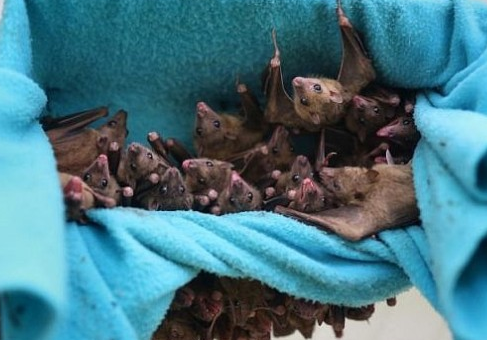Bats are sophisticated communicators. And not just when they're in vampire form.
蝙蝠可是经验丰富的交流者,而且不仅仅是在它们吸血时。
New research finds that Egyptian fruit bats actually have regional dialects, depending on the bat chatter that surrounds them as they grow up. The study is in the journal PLOS Biology.
新的研究发现,埃及果蝠实际上有自己的方言,这取决于在它们成长时聚集在周围的蝙蝠群的叫声。这项研究发表在《PLOS生物学》期刊上。
Among humans, one person's howdy is another one's g'day. Wild populations of bats also display group-specific vocalizations.
在人类中,有的人打招呼时“你好”这样说(howdy),有的人则是那样说(g'day)。蝙蝠的野生种群也显示着这种类属特异性的发声。
But how do these vocal characteristics arise? Do they reflect innate, genetic differences or are they learned?
但是,这些发声特色是如何形成的呢?它们是否反映了先天的遗传差异特性,还是后天习得的呢?
And if bat accents are acquired, who are these furry fliers imitating? Their parents? Or their roost-mates?
并且,如果蝙蝠的叫声是后天习得,那么这些毛茸茸的飞行员们是在模仿谁呢?它们的父母吗?还是它们的同伴?
To find out, Yossi Yovall at Tel Aviv University and his colleagues captured 15 pregnant fruit bats and divided them into three groups, each of which was housed in its own separate box. The mothers gave birth inside these boxes and their babies, called pups, lived there for a full year.
为了找到这个答案,特拉维夫大学的约西·约维尔和他的同事们捕获了15只怀孕的果蝠,并将它们分成三组,每组分别安置在独立的盒子里。母亲果蝠在这些箱子里生了小果蝠,并在这里住了一整年。

During that time, the researchers exposed the pups to a select symphony of bat sounds. Fruit bats in the wild are reared in colonies that contain dozens to thousands of individuals, so they're used to being surrounded by a cacophony of calls and other vocal communiques.
在这期间,研究人员将这些幼年蝙蝠暴露在一些特定的蝙蝠声音中。野生的果蝠是在有几十到数千个个体的群体中长大的,所以它们习惯于被一种刺耳的叫声和其他的声音所包围。
For one of the boxes, Yovall and his team exposed the young batlings to a selection of squeaks that were biased toward the higher frequencies. Pups in the second box heard lower-pitched peeps.
对于其中的一个盒子,约维尔和他的团队将小果蝠暴露在一些较高频率的吱吱声中。在第二个箱子里的小果蝠则听到低音。
And the third box got a random sampling of fruit bat hits that was heavy on the mid-range frequencies but also included those at either end of the aural spectrum. "And what we found is that they were influenced by the playback that they heard." said Yovall.
而第三个盒子里是一些随机取样的大声的果蝠中频声,也包括在听觉范围两端的高频音和低频音。约维尔表示:“我们发现,它们会受到所听到的回放声的影响。”
"So the control group was using a vocal repertoire that was identical to their mothers and identical to fruit bats in the colony here in Israel. But the two manipulated groups were using different dialects...we actually were able to create three different groups of fruit bats with three different dialects in the lab."
“所以,对照组使用了一个和它们的母亲完全一样的声音,和以色列区域的果蝠相同。但是,这两个被操纵的小组使用了不同的方言...实际上我们能够在实验室里用三种不同的组合方法创造出三组不同的方言。”
Of course, birds are famous for their songs. Which the males learn from tutors, typically their dads. But Yovall says when it comes to vocal learning, bats march to a different drummer.
当然了,鸟儿以它们的歌声闻名。雄鸟师从导师,通常是向它们的爸爸学习。但是约维尔说称,当谈到鸣叫学习时,蝙蝠可以学到不同的声音。
"Here we show that even though the pups were with their mothers, they were exposed to their mother's normal repertoire, they were still influenced by the background vocalizations that they heard."
“我们要表明的是,即使幼仔与它们的母亲在一起,接触到的是母亲正常的叫声,它们仍然受到它们听到的背景发声的影响。”












